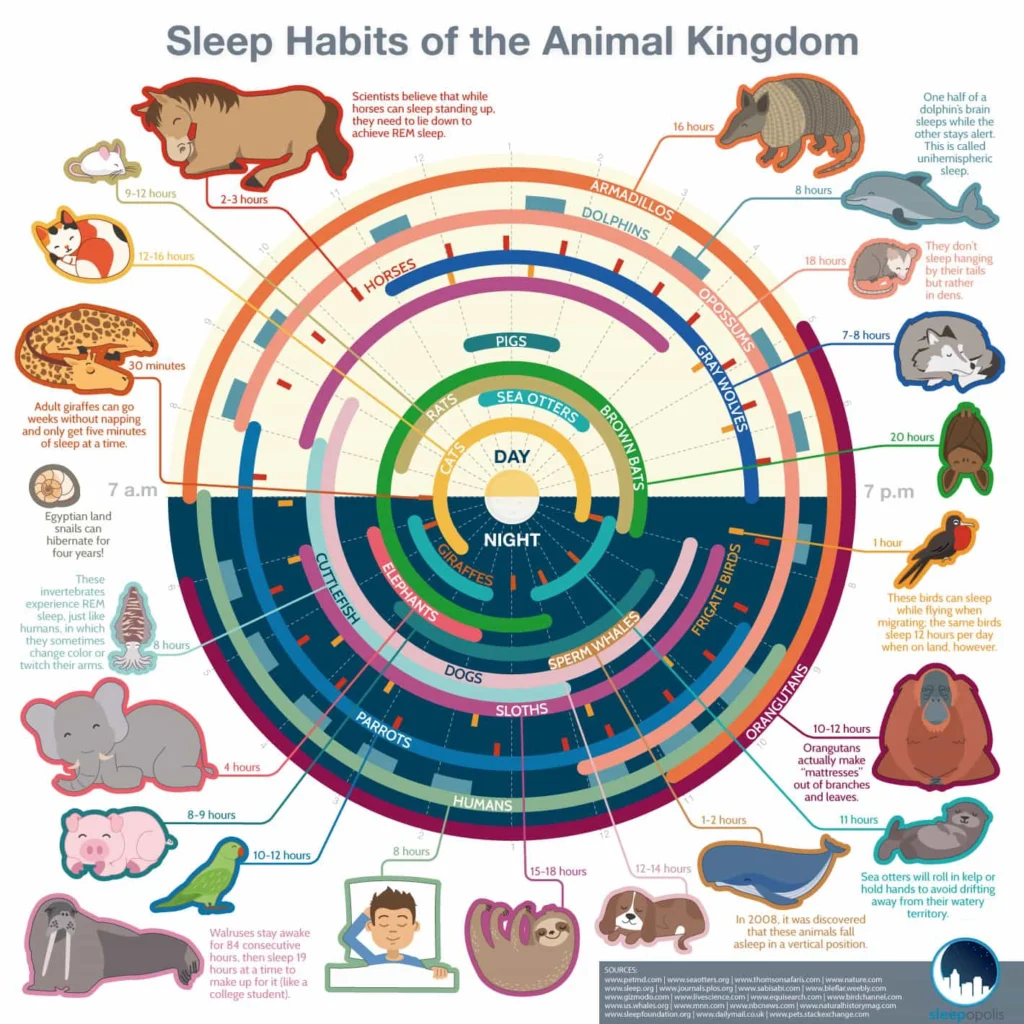Ever wondered how much sleep animals really get? From deep hibernations to five-minute catnaps, the animal kingdom reveals a fascinating variety of sleep patterns. The illustrated infographic “Sleep Habits of the Animal Kingdom” provides a colorful, clock-style overview of how long different species sleep, when they do it, and the unusual ways they rest.
Here’s a breakdown of some of the most interesting takeaways from the chart:

Shortest Sleepers in the Animal Kingdom
- Giraffes: Known for their minimal sleep, adult giraffes can go weeks without napping and may sleep only 30 minutes per day, often in 5-minute intervals.
- Frigate Birds: These birds sleep as little as 1 hour per day while flying and 12 hours when on land.
- Elephants: Wild elephants average around 4 hours of sleep per night and often sleep standing up.
- Walruses: These marine mammals can stay awake for 84 hours straight and then catch up with a long 19-hour sleep.
Longest Sleepers in the Animal Kingdom
- Brown Bats: Topping the chart, brown bats enjoy a staggering 20 hours of sleep daily.
- Opossums: Sleep about 18 hours a day, mostly during daylight.
- Sloths: These famously slow animals clock in between 15 to 18 hours of sleep per day.
- Armadillos: These small, nocturnal creatures sleep around 16 hours each day.
Unique and Bizarre Sleep Patterns
- Dolphins: They experience unihemispheric sleep, where only one half of the brain sleeps at a time, allowing them to remain partially alert.
- Sea Otters: These adorable animals float on their backs, often holding hands or anchoring to kelp, sleeping about 11 hours a day.
- Cuttlefish: These invertebrates show signs of REM sleep, with body movements and color changes, similar to dreaming in humans.
Day vs. Night Sleepers
- The infographic categorizes sleep cycles into daytime and nighttime sleep patterns.
- Humans generally sleep around 8 hours, during nighttime.
- Predators like gray wolves and lions are more nocturnal, sleeping during the day and staying alert at night.
- Herbivores like horses, though they can doze while standing, need to lie down for REM sleep, sleeping only 2-3 hours in total.
Fun Sleep Facts
- Egyptian Land Snails can hibernate for up to 4 years without waking up.
- Orangutans build “mattresses” in trees to sleep more comfortably.
- Humans, compared to most animals, have moderate sleep needs at 7–9 hours a day.
Visualizing Animal Sleep Cycles
The circular diagram uses a 24-hour clock to represent when animals sleep, offering a comparative view of species’ sleep duration and timing. Whether it’s nocturnal habits or bizarre REM behavior, this chart is a great educational tool for students, animal lovers, and sleep science enthusiasts alike.
Conclusion: Sleep is Wildly Diverse in the Animal Kingdom
From brief naps to marathon slumbers, the sleep habits of animals are as diverse as the species themselves. Whether it’s the alert, half-asleep dolphin or the snoozing sloth, the ways animals rest reveal just how adaptable and fascinating life on Earth really is.
Credit Source: sleepopolis.com







![The Science Of Building Buyer Personas [Infographic]](https://samplevisualization.com/wp-content/uploads/2014/12/The-Science-Of-Building-Buyer-Personas-Infographic-feature-image-300x225.webp)


![Saving Energy In The Home [InfoGraphic]](https://samplevisualization.com/wp-content/uploads/2014/07/Saving-Energy-In-The-Home-InfoGraphic-feature-image-300x225.webp)